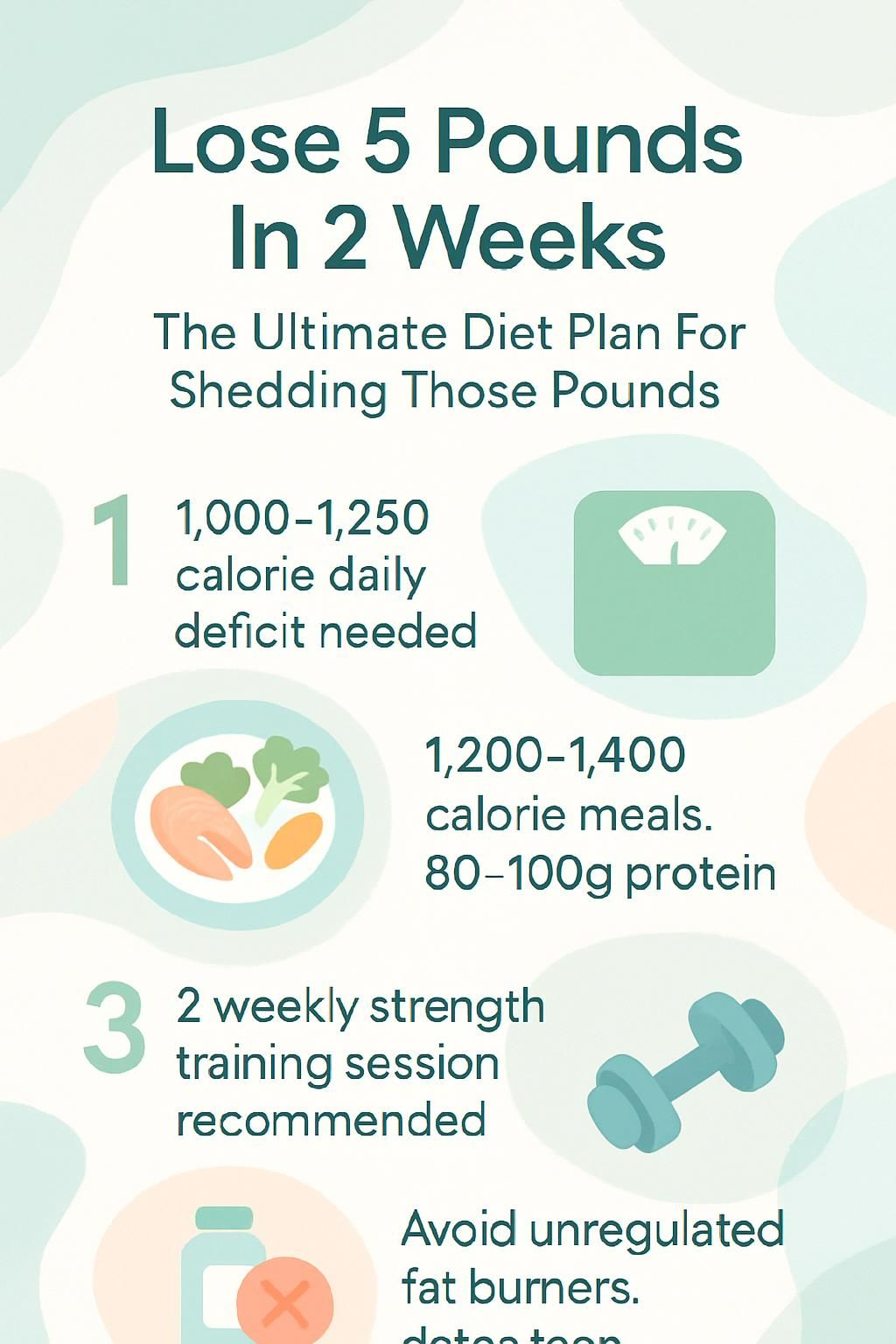Lose 5 Pounds In 2 Weeks: The Ultimate Diet Plan For Shedding Those Pounds
Our Nutrition Assistant AI Suite will transform your body. You will lose fat, get toned, and build muscle. Gain confidence and optimal health.
If the scale has stalled, you can still lose 5 pounds in 2 weeks with a smart plan. A safe pace is usually 1 to 2 pounds per week, yet a short push is possible with structure and care. This guide shows you how to use a calorie deficit, nutrient-dense foods, a simple meal plan, and effective exercise.
You will learn practical steps you can keep after these two weeks. The goal is steady fat loss, better energy, and habits that last.
Key Takeaways
- To approach five pounds in two weeks, create a daily calorie deficit of about 1,000 to 1,250 calories using food changes and exercise, in line with Centers for Disease Control and Prevention guidance.
- Meal plans around 1,200 to 1,400 calories with 80 to 100 grams of protein, plus vegetables and whole grains, support fat loss and protect muscle.
- Combine moderate aerobic exercise with at least two strength training sessions each week to lift calorie burn and preserve resting metabolism, as noted by the American College of Sports Medicine.
- Track calories with an app or journal, choose water-rich low-sodium foods, and hydrate well to control hunger and lessen water retention.
- Avoid extreme calorie cuts, unregulated fat burners, and detox teas. These may harm metabolism, reduce nutrients, and lack FDA review for safety.

Understanding the Basics of Weight Loss

Weight loss starts with two ideas, calories and metabolism. Calories are energy from food. Metabolism is how your body uses that energy for basic functions and movement.
What is a calorie deficit and how does it work?
A calorie deficit means you eat fewer calories than your body burns each day. Your body then taps stored fat for energy to close the gap. A common rule is that one pound of fat equals about 3,500 calories.
To lose five pounds in two weeks, the total deficit is about 17,500 calories. That averages 1,250 calories per day. The CDC suggests a safer daily deficit near 1,000 calories for most adults.
You can split the target into food and movement. For example, cut 750 calories from food and burn about 250 through exercise.
During my last cut, I logged meals, chose whole grains, lean protein, and fruit, and walked briskly for 30 minutes. Energy stayed steady and hunger was manageable.
Creating a calorie deficit is the foundation for losing weight, but making sure you get enough nutrients keeps you feeling your best during the process.
How does metabolism affect weight loss?
A calorie deficit drives loss, yet metabolism sets your pace. Basal metabolic rate, or BMR, is the calories your body uses at rest for breathing, circulation, and digestion.
For many people, BMR accounts for about 60% to 75% of daily energy use, according to the McKinley Health Center at the University of Illinois at Urbana-Champaign. Hormones, including thyroid hormones and sex hormones, also influence BMR, especially in women.
If daily calories drop too low, under 1,200 for women or under 1,500 for men, metabolism can slow to conserve energy. A 2013 paper in The American Journal of Clinical Nutrition reported that severe restriction lowers BMR and can drive more muscle loss.
Fast drops on the scale often reflect water and glycogen, the stored form of carbs, more than real fat loss. Steady changes over two weeks come from balanced food choices and activity, not extreme cuts that risk muscle.
Key Strategies to Lose 5 Pounds in 2 Weeks
A clear plan beats a crash diet. Small daily actions add up, especially in a short window.
How can I create a calorie deficit safely?
Build a moderate deficit that trims fat while protecting health and muscle.
- Reduce food intake by about 750 calories per day using low energy density foods like spinach, apples, beans, and yogurt.
- Burn roughly 250 calories daily with moderate cardio such as brisk walking or cycling, at least 150 minutes each week.
- Avoid daily deficits over 1,250 calories. Large gaps raise the risk of nutrient shortfalls and muscle loss.
- Track all foods and drinks in an app or food diary, including condiments and cooking oils.
- Center meals on whole foods. Limit processed items high in added sugars and unhealthy fats, consistent with the Dietary Guidelines for Americans.
- Include protein at each meal. Chicken, fish, tofu, beans, and yogurt help preserve skeletal muscle during weight loss.
- Drink water in place of sweetened drinks. Hydration supports appetite control and overall energy.
- If new to exercise, increase slowly and stop with pain to prevent injury.
- After the initial loss, add back 250 to 500 calories per day in small steps to reduce rebound weight gain.
- If you have diabetes or other chronic conditions, talk with your healthcare provider before cutting calories significantly.
What are the best ways to track daily calorie intake?
Accurate tracking helps you reach your target deficit and spot trends.
- Use a calorie tracker app such as MyFitnessPal or the Mayo Clinic Diet tools to log every item, even snacks and beverages.
- Scan barcodes on packaged foods to pull in nutrition data, including sodium and added sugar.
- Weigh portions with a digital kitchen scale. Estimating leads to errors.
- Read labels for serving size, calories, carbs, and dietary fiber per portion.
- Prefer paper and pen? Keep a written food journal and record each meal, like breakfast toast, lunch chicken, and dinner vegetables.
- For home recipes, enter each ingredient in your app or journal, including sauces and dressings.
- Check the Dietary Guidelines for Americans or Mayo Clinic resources to find suggested calories per day by age, sex, and activity.
Next, see how nutrient-dense foods make a deficit easier and more satisfying.
Diet Tips for Effective Weight Loss
Nutrient-dense foods pack vitamins, minerals, and fiber into fewer calories. They keep you full and support health while you lose weight.
Which nutrient-dense foods should I focus on?
Build meals around leafy greens, high fiber fruits, lean proteins, and water-rich vegetables. The Mayo Clinic Diet and Mediterranean plans both emphasize produce such as spinach, kale, berries, and oranges.
Choose proteins like grilled chicken, turkey, fish, tofu, and beans. Aim for 80 to 100 grams of protein per day, especially if you lift weights. This helps protect muscle.
Whole grains like oats and quinoa add fiber and steady energy. Nuts and seeds supply healthy fats that support heart health. I often prep overnight oats with berries, which helps control hunger through busy mornings.
Simple meals like white bean soup or sheet-pan roast chicken with broccoli fit a tight schedule. These choices are rich in vitamins and fiber, and they align with preventive healthcare goals.
How can I reduce processed food intake?
Cutting processed food trims calories and sodium without sacrificing taste. Swap a fried chicken sandwich for grilled chicken over greens with a light vinaigrette. That change can save hundreds of calories.
Pick whole snacks like carrot sticks with a tablespoon of hummus instead of pretzels. You cut calories and gain fiber. If certain foods trigger bloating, like excess sodium or sugary desserts, limit them.
Planning meals helps you avoid last-minute choices that add empty calories. Keep a list of go-to ingredients so you can spot hidden sources of salt and fat.
Why is staying hydrated important for weight loss?
Water supports fat burning and appetite control. Drinking 2.5 to 3 liters per day helps reduce bloating and keeps metabolism on track.
Morning water with lemon, ginger, or a splash of apple cider vinegar may help you start the day with better hydration and fewer cravings. Foods high in magnesium, like spinach, seeds, and almonds, plus options like dandelion tea or cucumber water, can help with water retention.
Having a cold lemon water before breakfast helped me feel fuller and cut snacking. Small habits like this are easy wins.
Sample 2-Week Meal Plan
Structure makes tough goals easier. Use this calorie-controlled guide as a starting point and adjust based on hunger and activity.
What does a balanced 1200–1400 calorie meal plan look like for week 1?
Keep meals between 1,200 and 1,400 calories per day. For breakfast, try Greek yogurt with berries. A protein smoothie with almond butter works as a mid-morning snack.
Lunch could be a grilled chicken salad loaded with colorful vegetables. In the afternoon, have raw almonds or carrot sticks. For dinner, bake salmon or tofu with steamed broccoli and quinoa.
Finish eating by 7 p.m. to protect your daily calorie deficit. Use lean proteins like shrimp, egg white omelets, and tofu to support muscle. High fiber produce keeps you full and focused, which helps you stick to losing 1 to 2 pounds per week.
Choose lower sodium items to reduce puffiness. Simple, steady habits beat short cuts.
How should I adjust portions in week 2 for progress?
Weigh yourself most mornings and look at the weekly trend. If hunger is high or progress stalls, raise intake by 100 to 150 calories per day after week two.
Some people add small portions of whole grains or starchy vegetables. Energy improves without rapid regain. Keep logging meals and favor nutrient-dense foods. This helps prevent emotional eating and rebound weight gain.
These habits set you up for the next stage, where exercise boosts your results.
The Role of Exercise in Weight Loss
Movement is like a second lever next to your diet. It increases calorie burn and supports bone health.
What cardio workouts burn the most fat?
Running at 5 mph for about 50 minutes helps a 155-pound person burn roughly 500 calories. High-impact step aerobics can offer similar burn in less time for heavier individuals.
High-Intensity Interval Training, or HIIT, alternates hard efforts with short rests. This raises heart rate and can increase total calories burned in less time.
I mix brisk walking or cycling with one HIIT session each week. The variety keeps workouts interesting and recovery smoother. When paired with a calorie deficit and hydration, this blend supports faster fat loss.
How does strength training help preserve muscle?
Strength training tells your body to keep muscle during a deficit. Without it, more of the loss can come from muscle instead of fat.
Plan at least two strength sessions each week. Bodyweight moves like push-ups and squats or free weights both work. Aim for 80 to 100 grams of protein per day to support recovery.
When I added two lift days per week, my arms and legs felt stronger as the scale moved. Research summarized by the American College of Sports Medicine in 2023 supports combining resistance training with protein to preserve lean mass.
Skipping this step often means lower muscle, a slower metabolism, and easier regain.
How can I incorporate daily physical activity effectively?
- Schedule at least 30 minutes of daily movement. Start shorter if needed and build up each week.
- Mix formal workouts with lifestyle activity such as dog walks, stairs, and quick stretch breaks.
- Use a step counter or fitness tracker for feedback and motivation.
- Pick activities you enjoy, like cycling with a friend or an evening yoga class.
- Alternate hard days with lighter recovery days to prevent injury and support muscle repair.
- Log your activity in an app or journal so you can spot patterns.
- Do both cardio and resistance work. The combination burns calories and protects muscle.
- Consider a class or workout partner to stay consistent, especially with goals like losing 0.5 to 1 pound per week.
Exploring Popular Diet Approaches
Different plans can work if they help you stay in a calorie deficit. Pick the structure that fits your lifestyle, not the one that looks trendy.
What is intermittent fasting and does it help weight loss?
Intermittent fasting, or IF, cycles between eating windows and fasting periods. The 16:8 method uses an 8-hour eating window, such as noon to 8 p.m., then fasts for 16 hours. The 5:2 method includes normal eating for 5 days and 500 to 600 calories on 2 non-consecutive days.
Reviews from the U.S. National Library of Medicine show IF can match standard calorie restriction for weight loss. It may also help blood sugar control in people with diabetes and obesity.
I found IF easier to follow than daily counting. If you prefer clear eating times, it might help you stay consistent. If you take medication or have conditions like cardiovascular disease or hypertension, consult your doctor first.
How do low-carb or keto diets work for losing weight?
Low-carb and keto plans reduce carbohydrates, which limits glucose and pushes your body to burn fat for fuel. Early weight drops often include water loss, sometimes 2 to 3 pounds in the first 2 to 3 days.
Cutting refined carbs and choosing non-starchy vegetables also lowers calories. Many people with insulin resistance or PCOS find this structure helpful for blood sugar control.
Short-term use can support a goal like 5 pounds in 2 weeks. If you have medical conditions, get guidance to personalize carb levels and protein needs.
What are the benefits of a low-calorie balanced diet?
A low-calorie balanced plan includes all food groups while creating a deficit. Produce is unlimited in some models, such as the Mayo Clinic Diet, which lowers the chance of nutrient gaps.
You do not need to count every bite. That lowers stress and improves long-term adherence. Most people feel satisfied while losing around 1 to 2 pounds per week.
On busy days, this approach kept my energy steady and the scale trending down. Balance builds skills you can keep after these two weeks.
Lifestyle Habits That Support Weight Loss
Daily routines often matter as much as the foods you pick. Small habits reduce stress, hunger, and cravings.
How much sleep do I need for weight loss?
Aim for 7 to 9 hours of sleep per night. Poor sleep can slow fat loss and raise cravings for carbs and sweets.
Quality sleep supports hunger hormones and stable energy. Limit screens before bed and try herbal tea to unwind. A set schedule also reduces late snacking.
If you use weight loss medications or plan to start them, make sleep a core habit. It supports results and makes hard days easier.
How can I manage stress and avoid emotional eating?
Stress can trigger emotional eating, especially in women. Higher cortisol levels often increase cravings for sugary and salty foods.
Use a food and mood journal to spot triggers. Practice deep breathing and mindful eating to slow down at meals and check true hunger signals.
If overeating feels frequent or hard to control, consider counseling. Writing down what I ate and how I felt helped me replace snacks with a walk or a quick call to a friend.
Why should I avoid late-night snacking?
Evening eating often adds extra calories that are easy to overlook. Metabolism tends to slow later in the day, which may lead the body to store more of these calories.
Many experts suggest finishing food two to three hours before sleep. This supports digestion and makes it easier to hit your daily calorie goal.
Skipping late snacks reduced my cravings and improved sleep quality. It also made morning hunger more predictable and easier to manage.
Dealing with Water Weight and Bloating
Water weight can mask your hard work. Small changes lower bloat and help the scale reflect real progress.
How can reducing sodium intake reduce bloating?
High sodium intake makes your body hold extra water. Processed foods and restaurant meals often carry large sodium loads, which can cause puffiness the next day.
Shift to fresh vegetables, fruits, lean proteins, and whole grains. This helps your kidneys release extra fluid and eases bloating within days. Lowering sodium by even 1,000 milligrams per day can reduce swelling, according to the CDC Dietary Guidelines for Americans.
What foods help combat bloating?
Several foods support smoother digestion and less water retention.
- Spinach offers magnesium that relaxes the digestive tract. Add it to salads or smoothies.
- Pumpkin and sunflower seeds supply magnesium and fiber for regularity.
- Almonds give healthy fats and fiber. Keep to a small handful to manage calories.
- Leafy greens like kale or romaine contain lots of water and vitamins.
- Cucumber, celery, and zucchini act as gentle natural diuretics to help flush sodium.
- Berries, apples, and pears provide fiber that promotes regular bowel movements.
- Dandelion tea can support mild water loss in a safe way.
- Cucumber water is a low-calorie drink that can ease puffiness during the day.
These choices helped me feel lighter during a recent two-week challenge. The difference showed up in the mirror and in how my clothes fit.
Supplements: Are They Necessary?
Supplements can offer small support. Food quality and habits do most of the work.
Which supplements may support weight loss?
Some supplements show modest benefits in research. Use them wisely and only as add-ons.
- Caffeine from coffee or green tea can raise daily energy use by roughly 80 to 150 calories in some people.
- Green tea extract with EGCG may slightly increase fat burning over several weeks.
- Glucomannan, a soluble fiber, can increase fullness. Some trials report several pounds of loss over eight weeks when paired with a calorie-controlled diet.
- Protein powder helps you reach daily protein targets and protects muscle during a deficit.
- On busy days, a quick shake kept me satisfied until my next meal.
- Many popular fat burners, like raspberry ketones or garcinia cambogia, lack strong evidence and may not be safe.
- Speak with a healthcare provider before starting any supplement, especially if you use medications or have health conditions.
Evidence-based supplements may help a little. The core is still a calorie deficit, nutritious meals, and regular activity.
What supplements should I avoid and why?
Some products promise fast results but carry risks or weak evidence.
- Avoid unregulated fat burners. These may include unsafe chemicals that can harm your heart or liver. Most are not reviewed by the FDA before sale.
- Skip detox teas sold for quick loss. Claims are not supported and side effects can include dehydration and irregular heartbeat.
- Avoid week-long juice cleanses. They are low in protein and key nutrients, which slows metabolism and increases muscle loss.
- Do not use non-prescription appetite suppressants bought online. Interactions and side effects are unpredictable.
- The Mayo Clinic does not endorse over-the-counter weight-loss products due to limited evidence and safety concerns.
- Ignore miracle claims like losing 5 pounds in a week through pills alone. Quick results are often water that returns fast.
- Be cautious with unknown herbal blends. Some include hidden drugs or allergens.
- Avoid unsupervised injections of peptides or hormones. Misuse can lead to serious medical problems.
Common Pitfalls to Avoid
Smart planning prevents backtracking. Avoid these traps to protect your progress.
What are unrealistic expectations during weight loss?
Expecting to lose five pounds of pure fat in seven days is not realistic. Since one pound of fat equals about 3,500 calories, that would take a 17,500 calorie deficit in a week, which is not safe.
Rapid scale swings usually reflect water and glycogen shifts. Travel, PMS, and salty meals can push weight up fast without adding fat. I once cut all carbs and saw a quick drop, then most of it returned when I ate normally again.
Why is over-restricting my diet harmful?
Going below 1,500 calories per day can cause nutrient gaps and slow metabolism. You may lose muscle and even bone strength without enough protein, healthy fats, vitamins, and minerals.
Severe restriction can lead to fatigue, dizziness, and irritability. Many people regain weight after extreme dieting ends. A balanced plan with nutrient-dense foods is safer and more sustainable.
What are the risks of skipping meals?
Skipping meals can lower your metabolism and reduce daily energy. It also raises the chance of overeating later. People who skip often reach for high sugar and high calorie foods under stress.
Spread calories across regular meals to control hunger and stay focused. When I skipped breakfast, I felt tired and then overate at lunch.
Summary Table: Risks of Skipping Meals
| Risk Factor | Possible Outcome |
|---|---|
| Slower metabolism | Reduced calorie burn |
| Nutrient deficiency | Fatigue and weaker immunity |
| Overeating | Higher calories at the next meal |
| Emotional eating | More processed and sugary foods |
How to Maintain Your Progress After 2 Weeks
Protect your results with gradual changes. Maintenance is a skill, and it can be learned.
How do I gradually increase calorie intake after dieting?
Add 100 to 150 calories per day each week after the two-week plan. Weigh yourself every few days to watch trends, not single days. Choose nutrient-dense foods like whole grains, nuts, seeds, and healthy fats.
Increase in small steps so your body adapts. Use an app or journal to track changes. If weight climbs too fast or stalls for weeks, adjust slightly.
What healthy eating habits should I continue?
Keep a variety of vegetables, lean proteins like chicken breast and fish, and high fiber foods such as whole grains, beans, and berries. The CDC suggests filling half your plate with vegetables.
Limit processed foods, extra sodium, and added sugars to reduce regain risk. Practice mindful eating. Sit down, avoid screens, and watch portions. A 2022 JAMA study found that people who track portions are less likely to overeat.
How can I set effective long-term weight loss goals?
Focus goals on daily actions, not just the scale. Track what you eat and how you move to spot patterns.
Good targets include cooking more meals at home, walking 8,000 steps daily, and drinking eight glasses of water. Aim to lose 1 to 2 pounds per week for a sustainable pace.
Celebrate wins like better sleep, more energy, or looser clothes. Adjust goals as you learn what fits your life and schedule.
When to Seek Professional Advice
Personal health needs vary. Expert guidance helps you tailor a plan and stay safe.
When should I consult a nutritionist or dietitian?
See a registered dietitian if you notice signs of nutrient gaps, such as hair loss, ongoing fatigue, or skin issues. Constant hunger that does not improve with tweaks also signals a need for help.
Specialists can guide people with PCOS, menopause symptoms, or insulin resistance. If you have diabetes, get professional input before starting a restrictive plan.
Personalized advice lowers health risks and strengthens long-term results.
What medical weight-loss options are available?
Prescription options, such as semaglutide and other injections, can help some people when combined with diet and exercise. Doctors may also check thyroid function, hormone levels, or insulin resistance if fat loss is unusually slow.
Medical tools work best with core habits like calorie tracking, balanced meals, and daily movement. Always work with your healthcare provider to choose safe options.
FAQs About Losing 5 Pounds in 2 Weeks
Rapid loss sounds appealing, but early drops often reflect water, glycogen, and lower inflammation. The CDC advises losing 1 to 2 pounds per week for safety.
Two-week efforts usually include some water loss, not just fat. That is normal. Set expectations that protect your health and your mood. Focus on habits you can keep once those first pounds are gone.
If you need help with a meal plan or ongoing dieting, a registered dietitian can guide you.
Conclusion
Reaching a goal like losing 5 pounds in 2 weeks takes planning and patience. Build a smart calorie deficit, choose balanced meals, and move your body most days.
Fill half your plate with fruits and vegetables. Add lean protein and whole grains to protect muscle while you burn fat. Hydrate well and limit processed foods to improve results.
Check in with your doctor before any rapid plan, especially if you have medical conditions or take medication. Track, adjust, and keep the habits that work for you. This approach helps you lose weight safely now and maintain results over time.
FAQs
1. How can I lose 5 pounds in 2 weeks using a diet plan?
A calorie deficit is key for weight loss. Studies show that reducing daily intake by 500 to 1,000 calories can help most people lose about 1 to 2 pounds per week. Eating more vegetables, lean proteins like chicken or fish, and whole grains supports this goal. Tracking food intake and staying hydrated also help.
2. What foods should I avoid to shed those pounds quickly?
Limit foods high in sugar and saturated fat. Processed snacks, sugary drinks, and fried foods can slow progress. Research from the Centers for Disease Control and Prevention shows that cutting out these foods helps reduce calorie intake and supports weight loss.
3. Is exercise necessary for losing 5 pounds in 2 weeks?
Physical activity increases calorie burn and supports muscle retention during weight loss. The American Heart Association recommends at least 150 minutes of moderate aerobic activity each week for adults. Combining regular movement with a healthy diet improves results.
4. Are there risks to rapid weight loss on a strict diet plan?
Losing weight too quickly may cause fatigue or nutrient deficiencies. Experts advise aiming for steady progress rather than extreme restriction. A balanced plan that includes all food groups lowers health risks while helping you reach your target.
Personal Experience: I followed a similar plan by preparing meals ahead of time and choosing whole foods over processed options. This made it easier to stick to my goals.
Summary: A structured diet plan focused on calorie control, healthy food choices, physical activity, and realistic goals can help you lose 5 pounds in two weeks safely. Avoiding high-calorie processed foods while staying active improves your chances for lasting results.







